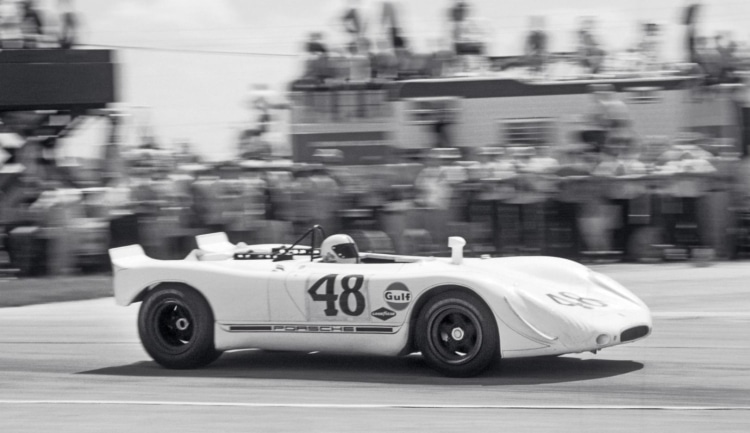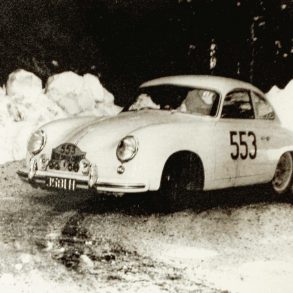In a letter dated March 1970, Ferry Porsche congratulated Steve McQueen and his co-driver Peter Revson on their impressive performance at the 12 Hours of Sebring.
In the letter, Porsche wrote:
“Dear Mr. McQueen, It is a great pleasure to extend my warm congratulations to you on your outstanding performance at the 12 Hours of Sebring. You can imagine how delighted I was that you posted such a brilliant result in a car of our brand.”
Ferry Porsche
At 40 years of age, Steve McQueen’s success was not restricted to the Hollywood screen, but also an eager racer.
Undeniably, what McQueen and Revson were able to do was nothing short of amazing at the classic long-distance race in Florida.

Despite their Porsche 908/02 Spyder KH (Kurzheck or short tail), nicknamed ‘Flounder,’ being outmatched by their more powerful competitors in the higher class, they were still able to lead up to the final stages of the race.
It was only during the last lap that a Ferrari, driven by Mario Andretti, took the lead. McQueen crossed the finish line just 23 seconds after 12 hours at race pace.
Always having the drive to win, McQueen hated being second, but even he knew that the second-place finish was a great feat in more ways than one. Just two weeks before, he injured his left foot at Lake Elsinore in a motocross race and arrived at Sebring with a cast and on crutches.

McQueen nonchalantly explained to the reporters who were eagerly awaiting updates:
“The foot’s broken in six places. We had to shorten the left pedal in the car and glue sandpaper to the sole of my shoe for me to be able to work the clutch.”
Steve McQueen
He never did think to back out of the race, stating, “I had given my word.”
That summed up McQueen- The Hollywood cool guy that always pushed the boundaries and broke the rules, not only in his blockbuster movies like Bullitt, The Magnificent Seven, and The Towering Inferno, but the same in real life and in racing.
His son, Chad, described his passion, stating, “He loved racing. It was his drug.”
He grew up in Missouri and Indiana. When he was 14, he was in a home for delinquent youths. By the time he was 17, he enlisted himself in the Marines as a tank driver. When he was 22, he auditioned to get one of the highly desired, and very limited spots in Lee Strasberg’s famous Actors Studio in New York – considered to be the best drama school in the 1950s.
To pay for bills, McQueen took to truck driving and being a dishwasher, and added to the finances by racing his Harley-Davidson.
Before the 1950s ended, McQueen was able to buy himself his first new car: a black Porsche 356 A Speedster.

Like his colleague James Dean, the actor was also attracted to Porsche. His Speedster combined the best of both worlds- a daily driver with the characteristics of a club racer.
In 1959, McQueen entered nine races from Sports Car Club of America. On May 31, in Santa Barbara, in his first official race, he won in the novice class. McQueen later shared:
“I was hooked. Racing gave me a new identity and it was important to me to have that independent identity.”
In the summer of 1959, McQueen traded his Speedster to get a more powerful Porsche 356 A Carrera. He eventually entered his first race in a true race car, a Lotus Eleven.
Throughout his 20-year career, he acquired more sports cars and racing machines. He was a collector, amassing not only cars but also motorcycles and aircraft.
His obsession with his toys was his means to deal with everything happening in his life, as he once stated:
“I can really only relax when I’m racing. I loosen up at high speeds.”
His assistant director, who had worked with him for a number of years, Clifford Coleman, shared, “He had to overtake you, that was his personality. That’s why he was so successful. He had to win.”
His passion to win was not only limited to the racetrack but extended to his collection. When McQueen learned that Bruce Meyer from Beverly Hills, another race car driver, was able to acquire his Porsche 356 A Speedster for $1,500, he did not lay off Meyer until the latter gave it back to him. McQueen kept the car for the rest of his life.

Even McQueen’s films were made according to his rules. Since he was one of the biggest actors in the 1960s, he got what he wanted. He was able to insert his cars and motorcycles into the plotlines, like in The Thomas Crown Affair where he drove his VW Buggy in a madcap beach drive with Faye Dunaway.

For Bullitt, he insisted on doing the stunts himself, especially for the legendary chase scene instead of a stunt double, a potential disaster-awaiting for a Producer. Having their main star injured would mean dealing with losses worth millions.
Yet despite having the success of numerous blockbuster films, he could not resist the call of motocross races.
Racing under the pseudonym, Harvey Mushman, McQueen enjoyed anonymity provided by the helmet. However although he could hide behind the helmet from the public, he was not able to hide his driving style.
Coleman recalled:
“He was strong and fast. That was evident in the way he rode a motorcycle – very aggressively.”

It was not long before he developed increasing attention for his racing, especially considering his co-drivers were some of the best in the world like Innes Ireland, Stirling Moss, and Pedro Rodriguez.
Using his own company Solar Productions, McQueen financed his own racing team. The peak of his career was on March 21, 1970 at the 12 Hours of Sebring, one of the ten races in the World Sportscar Championship season.


At the time, hoping to repeat their previous year’s world championship victory, Porsche brought seven cars to the starting line – four of them being 917 KH models.
Despite this, all focus was on McQueen and his co-driver Peter Revson that registered the 908/02 as a private team. McQueen and the 908/02 already had a history as he had driven it to victory in Holtville and Phoenix.
Porsche driver Kurt Ahrens who drove one of the 917 with his co-drive Vic Elford had his eyes on McQueen during training. The now 80-year-old recalled:
“McQueen had a lot of talent, and he was ambitious, practically obsessed. And he was fast, even if not quite as fast as Revson.”

As the 3-liter Spider could only produce 350hp, it was an uphill battle against the 5-liter class that produced 600hp.
To make up for their slower lap times, the team decided not to change tires or brake pads for the duration of the whole race. Ahrens shared, “We were all surprised how consistently they drove; the rigors of the race were considerable. The track was made of concrete slabs; it gave us a good rattle.”

It should also be noted that McQueen had a broken foot, but even that did not stop him. Their pit strategy worked, and it gave them their impressive second place.
The factory team Porsche led by Leo Kinnunen, Jo Siffert, and Pedro Rodriguez came fourth, after a pit stop that took longer than expected, a result not what Porsche was aiming for.
In his letter to McQueen, Ferry Porsche stated:
“Your finish enabled us to keep the lead in the Manufacturers’ World Championship, and for that I would like to thank you.”
Both the head of Porsche and McQueen were looking forward to the much-awaited event in the annual racing calendar with enthusiasm – the 24 Hours of Le Mans.
McQueen was planning on joining the race alongside Formula One champion Jackie Stewart in a Porsche 917. Unfortunately, for insurance reasons, and having to go up against Hollywood brass, McQueen backed down, seemingly for the first time in his life.
He contented himself to preparing from the trackside for his racing movie, Le Mans with having the 908/02 from Sebring as a film car. Herbert Linge and Jonathan Williams were tasked to get authentic racing scenes. They ended up getting a ninth place but were subsequently disqualified due to a controversial rule violation.

The race would produce the long-awaited triumph for Porsche as Hans Hermann and Richard Attwood was able to give Porsche their first overall victory at Le Mans in their red-and-white 917.
It was not long before McQueen started shooting the scenes for the movie that he has dreamt of for so long.
It was always his dream to make the ultimate film about racing, and Le Mans was his pet project. The production of Le Mans was not smooth sailing with the movie on the verge of collapse several times, threatening to ruin him financially and it took its toll on his marriage to Neile Adams.
John Sturges, the first director of Le Mans, was fired after wanting to add a love story with the 24-hour race as the backdrop. It was unacceptable for McQueen because for him, the race was the love story.

Lee H. Katzin, being the second director, gave to McQueen’s desires. Le Mans was released in 1971 with it taking many years before it got its cult status.
For the driving scenes in Le Mans, McQueen acquired the services of the best Le Mans professionals including a future five-time overall winner, Derek Bell.
Soon McQueen himself was roaring through the track in the 917. Bell recalled:
“Steve’s passion for speed was obvious: he wanted to drive full-throttle all the way. That’s probably why we got along so well.”
On November 7, 1980, at a young age of 50, Steve McQueen died of cancer.
“You only live once, so live life to the fullest.”
Steve McQueen
[Source: Porsche]











My painting of McQueen is the front piece in Matt Stone’s wonderful book “McQueen’s Machines”. The Bruce Meyer photo is in the book and I think the setting is the driveway of Steve’s house in Malibu. I lived in Malibu in 1972 with Bard college boyfriend Herb Ritts (who later became a major fashion and celebrity photographer) and Herb knew McQueen from growing up next door in Brentwood. Herb took me to Steve’s Malibu home for a visit (Ali McGraw lived with Steve at the time). I was an art major at Bard and Ali and I had art in common. I will forever remember that Sunday afternoon, Steve made drinks and we al sat on the beach.
great rage car driver and definitely a great movie star, one of the best
Excellent story! Thank You!
A wonderful storyline!
I watch ‘Dead or Alive’ reruns on Saturdays every time I am home. I drive a 1960 ‘Bugeye’ Sprite like Steve, Sterling and Pat Moss did at Sebring.
I am a big Steve McQueen fan but this story exaggerates his contribution to second place in this race.
Peter Revson did the majority of the driving, lapping 8 seconds per lap faster than McQueen. It was Revson, not McQueen as you state, who was at the wheel at the finish 23 seconds behind Andretti.
Steve McQueen greatly admired professional racing drivers and I’m sure he would have recognised that it was Peter Revson’s driving that got them second place.